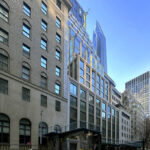Willem de Kooning’s 1949 painting, Gansevoort Street, is far from a photorealistic depiction of a New York City street. Instead, it offers a deeply personal and abstract interpretation, rendered in a dominant palette of reddish-orange. This oil on cardboard piece, measuring approximately two and a half by three and a half feet, invites viewers to explore the essence of Gansevoort Street through de Kooning’s unique artistic lens. Despite the seemingly monochromatic base, the painting is rich in tonal variations, achieved through masterful blending techniques.
De Kooning’s use of color is central to understanding Gansevoort Street. The pervasive reddish-orange is skillfully modulated by mixing it with blue, its complementary opposite, to create deep shadows and nuanced shading. White is introduced to lighten areas, suggesting varying degrees of brightness and even stark glare. Black lines, ranging from thick to thin, and executed with both deliberate precision and loose strokes, carve through the reddish-orange field, defining shapes and adding dynamic energy to the composition. The initial impression might be of a chaotic collage, yet closer examination reveals recognizable forms emerging from the abstract.
A key to deciphering de Kooning’s abstract Gansevoort Street lies slightly below the center of the canvas. Here, a distinct shape emerges that strongly suggests a chimney or ventilation shaft. Its square form topped with a triangular cap, along with its positioning relative to implied rooflines, anchors the viewer’s perspective. The angles of the chimney hint at the artist’s viewpoint, while the shading subtly indicates the sun’s low position in the sky. Notably, the right side of the chimney is rendered in a vibrant yellow, a color sparingly used elsewhere, creating a focal point. In contrast, the front face is shadowed in lavender and purple tones. To the left of this chimney element, where two roof edges converge, a suggestion of a street appears – the only explicit street-like form within the artwork and implicitly Gansevoort Street itself. This implied street, barely visible, seems to ascend gently, largely obscured across the rest of the painting. Its surface is lightened, as if catching direct sunlight, with a dark shadow line defining its near edge and a brighter line suggesting a curb on the far side.
Further solidifying the urban context of Gansevoort Street are rectangular and square shapes positioned to the right and left of the chimney respectively. These can be interpreted as windows in the foreground, adding depth to the scene. Across the upper portion of the painting, bold black lines dominate, possibly representing rooftops and awnings on the opposite side of Gansevoort Street. However, their abstract forms and angles deliberately challenge a straightforward, literal interpretation, inviting viewers to engage with the painting on a more imaginative level.
In the lower right corner of Gansevoort Street, de Kooning concentrates detail and applies daubs of white, yellow, and blue paint. This area, roughly shaped like a torso and head and larger than the chimney, could represent a figure in the immediate foreground. Building upon this interpretation, less defined, whitened torso-like shapes of diminishing size appear to suggest a series of pedestrians trailing behind the initial figure along a sidewalk. Overlapping the third figure in this implied line with the chimney is a white oval, strongly suggesting a head. The torso of the second figure is depicted as blue-black vertical strokes framing white patches, with an orange strip down the center, widening towards the bottom, resembling a tie peeking from an open jacket.
As one spends more time with Gansevoort Street, de Kooning’s abstract vision begins to coalesce. Details in other corners, a splash of maroon along the left edge, all contribute to a sense of place. The painting becomes evocative, potentially transporting those familiar with Gansevoort Street in 1949 back to that time and place, not through precise representation, but through a powerful, sensory impression captured in paint. De Kooning’s Gansevoort Street is not just a painting; it’s an experience, an invitation to visually and emotionally navigate a memory of a street transformed into art.


